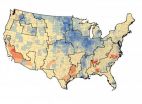(Press-News.org) This press release is available in Spanish.
Rising carbon dioxide (CO2) levels can reverse the drying effects of predicted higher temperatures on semi-arid rangelands, according to a study published today in the scientific journal Nature by a team of U.S. Department of Agriculture (USDA) and university scientists.
Warmer temperatures increase water loss to the atmosphere, leading to drier soils. In contrast, higher CO2 levels cause leaf stomatal pores to partly close, lessening the amount of water vapor that escapes and the amount of water plants draw from soil. This new study finds that CO2 does more to counterbalance warming-induced water loss than previously expected. In fact, simulations of levels of warming and CO2 predicted for later this century demonstrated no net change in soil water, and actually increased levels of plant growth for warm-season grasses.
"By combining higher temperatures with elevated CO2 levels in an experiment on actual rangeland, these researchers are developing the scientific knowledge base to help prepare managers of the world's rangelands for what is likely to happen as climate changes in the future," said Edward B. Knipling, administrator of the Agricultural Research Service (ARS), USDA's principal intramural scientific research agency.
The results cover the first four years of the eight-year Prairie Heating and CO2 Enrichment (PHACE) experiment on native northern mixed grass rangeland. The study is being conducted by the ARS Rangeland Resources Research Unit (RRRU) at the High Plains Grasslands Research Station near Cheyenne, Wyo.
ARS plant physiologist Jack Morgan leads the study, which uses both CO2 pipelines and thermal infrared heaters to simulate global warming conditions predicted for the end of the century: 600 parts per million (ppm) of CO2—compared to today's average 390 ppm—and day/night temperatures raised by 3 and 5 degrees Fahrenheit, respectively.
Based on these findings, warmer temperatures would likely play a role in changing the relative success of various grass types. "Only the warm-season grasses had their growth boosted higher by CO2 and warmer temperatures," Morgan said. "If this leads to a competitive advantage for warm-season grasses, it may increase the challenges faced by ranchers who desire cool-season grasses for early-season forage."
Elise Pendall and David Williams at the University of Wyoming at Laramie and Matthew Wallenstein at Colorado State University at Fort Collins also are participating in the study, which will be completed in 2013. Retired ARS soil scientist Bruce Kimball, designer of the infrared heater system, is helping conduct the study. Kimball serves as a research collaborator at the ARS U.S. Arid-Land Agricultural Research Center in Maricopa, Ariz.
Grass-dominated, dry rangelands account for approximately a third of the Earth's land surface, providing most of the forage eaten by livestock. This research, the first of its kind on this scale for rangelands, supports the USDA priority of helping farmers and ranchers throughout the United States and the rest of the world best adapt production practices to variable climate patterns.
Morgan said more research is needed to determine how the water-savings effect applies over the long run and in other types of semi-arid rangelands as well as to croplands in semi-arid areas. "It is important to understand that CO2 only offset the direct effects of warming on soil water in this experiment, and that it is unlikely to offset more severe drought due to combined warming and reduced precipitation projected for many regions of the world," he said.
INFORMATION:
In addition to ARS funding, the research is supported by grants from the National Science Foundation, the U.S. Department of Energy, and USDA's National Institute of Food and Agriculture.
USDA is an equal opportunity provider, employer and lender. To file a complaint of discrimination, write: USDA, Director, Office of Civil Rights, 1400 Independence Ave., S.W., Washington, D.C. 20250-9410 or call (800) 795-3272 (voice), or (202) 720-6382 (TDD).
USDA scientists study effects of rising carbon dioxide on rangelands
2011-08-04
ELSE PRESS RELEASES FROM THIS DATE:
Mayo Clinic examines why knee osteoarthritis afflicts more women than men
2011-08-04
JACKSONVILLE, Fla. — A Mayo Clinic orthopedic surgeon suspects that the nagging pain and inflammation that women can experience in their knees may be different from what men encounter, and she has been chosen to lead a novel U.S.-Canadian study to explore the question. The Society for Women's Health Research (SWHR) and its Interdisciplinary Studies in Sex-Differences (ISIS) Network on Musculoskeletal Health has awarded a group of researchers a $127,000 grant to lead a pilot project to understand whether biological differences between men and women affect the incidence and ...
Carbon hitches a ride from field to market
2011-08-04
RICHLAND, Wash. – Today, farming often involves transporting crops long distances so consumers from Maine to California can enjoy Midwest corn, Northwest cherries and other produce when they are out of season locally. But it isn't just the fossil fuel needed to move food that contributes to agriculture's carbon footprint.
New research published in the journal Biogeosciences provides a detailed account of how carbon naturally flows into and out of crops themselves as they grow, are harvested and are then eaten far from where they're grown. The paper shows how regions that ...
'Watermark ink' device identifies unknown liquids instantly
2011-08-04
Cambridge, Mass. - August 3, 2011 - Materials scientists and applied physicists collaborating at Harvard's School of Engineering and Applied Sciences (SEAS) have invented a new device that can instantly identify an unknown liquid.
The device, which fits in the palm of a hand and requires no power source, exploits the chemical and optical properties of precisely nanostructured materials to distinguish liquids by their surface tension.
The finding, published in the Journal of the American Chemical Society (JACS), offers a cheap, fast, and portable way to perform quality ...
UGA researchers use gold nanoparticles to diagnose flu in minutes
2011-08-04
Arriving at a rapid and accurate diagnosis is critical during flu outbreaks, but until now, physicians and public health officials have had to choose between a highly accurate yet time-consuming test or a rapid but error-prone test.
A new detection method developed at the University of Georgia and detailed in the August edition of the journal Analyst, however, offers the best of both worlds. By coating gold nanoparticles with antibodies that bind to specific strains of the flu virus and then measuring how the particles scatter laser light, the technology can detect influenza ...
GEN reports on nanotechology's impact on mass spectrometry
2011-08-04
New Rochelle, NY, August 3, 2011—A move toward smaller and smaller sample sizes is leading to a new generation of mass spectrometry instrumentation, reports Genetic Engineering & Biotechnology News (GEN). From a specific application point of view, novel nanoflow separation methodologies are ramping up the speed and precision with which scientists are able to validate biomarkers, according to the August issue of GEN (www.genengnews.com/gen-articles/nanoliter-volumes-push-ms-to-new-lows/3741).
"Basing biomarker validation on more sophisticated mass spec tools could help ...
Researchers develop and test new molecule as a delivery vehicle to image and kill brain tumors
2011-08-04
RICHMOND, Va. (Aug. 3, 2011) – A single compound with dual function – the ability to deliver a diagnostic and therapeutic agent – may one day be used to enhance the diagnosis, imaging and treatment of brain tumors, according to findings from Virginia Commonwealth University and Virginia Tech.
Glioblastomas are the most common and aggressive brain tumor in humans, with a high rate of relapse. These tumor cells often extend beyond the well-defined tumor margins making it extremely difficult for clinicians and radiologists to visualize with current imaging techniques. Researchers ...
New study calls into question reliance on animal models in cardiovascular research
2011-08-04
Anyone who follows science has read enthusiastic stories about medical breakthroughs that include the standard disclaimer that the results were obtained in mice and might not carry over to humans.
Much later, there might be reports that a drug has been abandoned because clinical trials turned up unforeseen side effects or responses in humans. Given the delay, most readers probably don't connect the initial success and the eventual failure.
But Igor Efimov, PhD, a biomedical engineer at Washington University in St. Louis who studies the biophysical and physiological ...
Bellybutton microbiomes
2011-08-04
Public awareness about the role and interaction of microbes is essential for promoting human and environmental health, say scientists presenting research at the Ecological Society of America's (ESA) 96th Annual Meeting from August 7-12, 2011. Researchers shed light on the healthy microbes of the human body and other research on microbial and disease ecology to be presented at ESA's 2011 meeting in Austin, Texas.
Bellybutton microbiomes
Human skin is teeming with microbes—communities of bacteria, many of which are harmless, live alongside the more infamous microbes sometimes ...
Mold exposure during infancy increases asthma risk
2011-08-04
Infants who live in "moldy" homes are three times more likely to develop asthma by age 7—an age that children can be accurately diagnosed with the condition.
Study results are published in the August issue of Annals of Allergy, Asthma & Immunology, the scientific journal of the American College of Allergy, Asthma and Immunology (ACAAI).
"Early life exposure to mold seems to play a critical role in childhood asthma development," says Tiina Reponen, PhD, lead study author and University of Cincinnati (UC) professor of environmental health. "Genetic factors are also ...
US physicians spend nearly 4 times more on health insurance costs than Canadian counterparts
2011-08-04
ITHACA, N.Y. — U.S. physicians spend nearly $61,000 more than their Canadian counterparts each year on administrative expenses related to health insurance, according to a new study by researchers at Cornell University and the University of Toronto.
The study, published in the August issue of the journal Health Affairs, found that per-physician costs in the U.S. averaged $82,975 annually, while Ontario-based physicians averaged $22,205 – primarily because Canada's single-payer health care system is simpler.
Canadian physicians follow a single set of rules, but U.S. doctors ...



